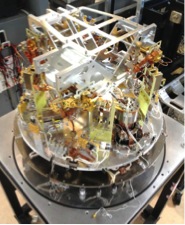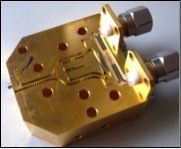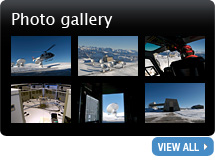The IRAM Frontend
 |
| The NOEMA Frontend |
The IRAM Frontend group develops and maintains cryogenic ultra-sensitive millimeter-wave superconducting heterodyne receivers, covering the ~70-375 GHz frequency range, for the two IRAM observatories (the NOEMA interferometer and the 30 meter telescope). Also, the group supplies devices and builds millimeter-wave receivers for other radio astronomy institutes and has active collaborations with international organisations. In particular, the team has a very successful record in developing low-noise wideband receivers with state-of-the art performance for its own telescopes (multi-band and multi-beam) and in designing and producing complex systems like the ALMA Band 7 receiver cartridge (73 cartridges were delivered to the ALMA project). The group has successfully developed room-temperature 18-26 GHz water vapour radiometers for NOEMA's predecessor, the Plateau de Bure interferometer and is currently building a 2nd generation version with improved capabilities.
The Frontend engineers and technicians cover all aspects of the millimeter-wave technology, including the design and manufacturing of:
- the coupling (quasi-)optics of the astronomical signal from the telescope into the receiver (including corrugated feed-horns, vacuum windows, IR filters and the calibration systems);
- the Superconductor-Insulator-Superconductor (SIS) waveguide mixers and couplers;
- the cryostats operating at temperatures below 4K using closed-cycle refrigerators;
- the Local Oscillator (LO) system and its distribution;
- the Intermediate Frequency (IF) amplification and filtering of the signal;
- the monitoring and control electronics of the receivers.
 |
| The NOEMA Band 2 (127-179 GHz) SIS mixer |
The team is also in charge of the onsite maintenance of the frontends. The institute’s laboratories are fully equipped with fast computers for the electromagnetic design and with modern instrumentation that include custom-made millimeter-wave Vector Network Analysers, antenna range systems, probe stations, wire-bonding machines and cryogenic test facilities allowing the characterization at the device level and at the instrument level. All the manufactured devices are special designs not available on the market.
The main advantage of having all the expertise in-house is the capability of maintaining state-of-the-art receiver systems. The receiver systems have been continously upgraded in the past 30 years, allowing for example to lower the sensitivities, increase the RF and IF range, have more integrated designs.
The group actively participates also in the project for a large field of view continuum camera (NIKA II) for the IRAM 30m telescope and in particular in the design of the related large field of view optics.
A list of publications detailing some of the work done in the Frontend Group can be found here.

